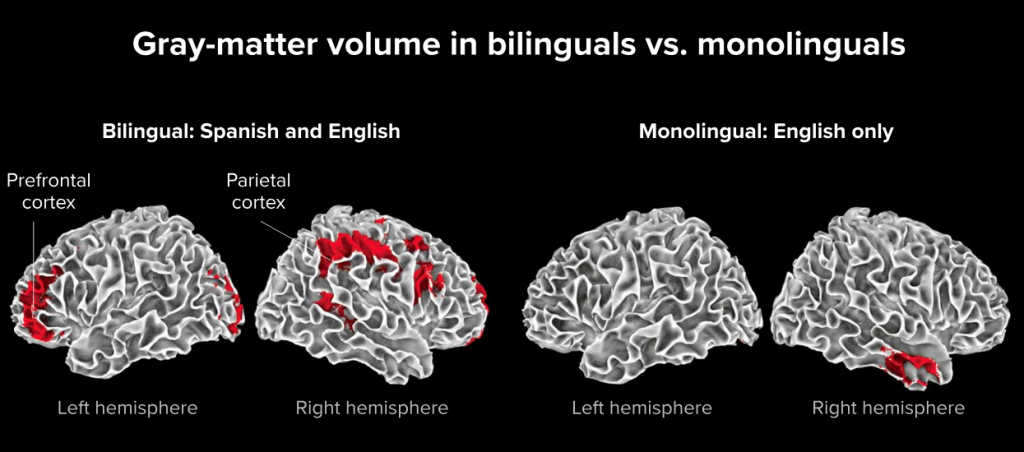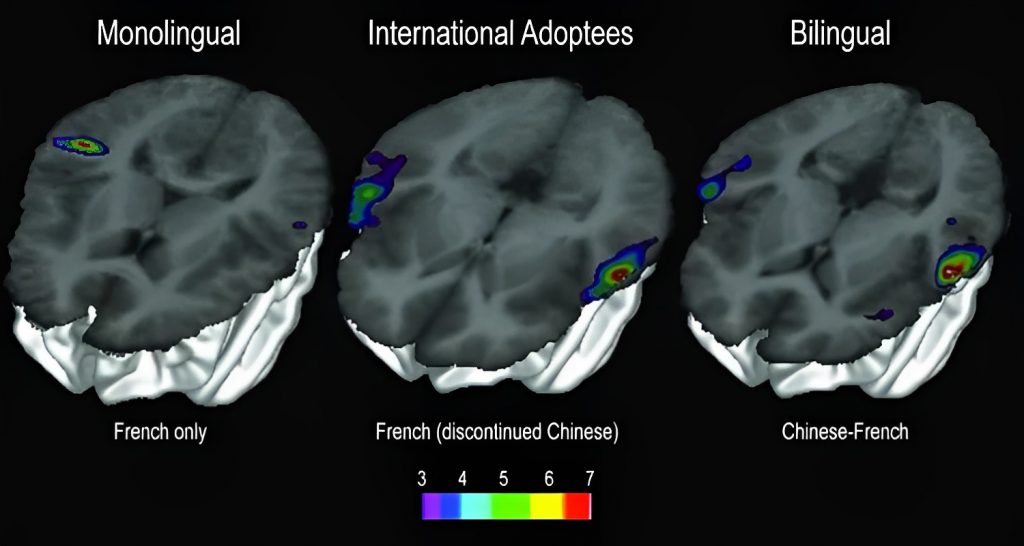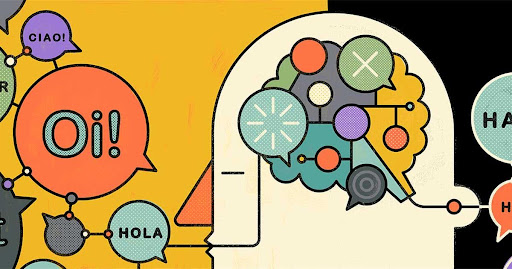What Benefits Can Being Bilingual Offer?
In 2011, a new bird came into existence. Found only among the expansive networks of digital technology, this green animated bird named Duo reminds users to complete their daily language-learning lessons. As the mascot of Duolingo—an educational application designed to help users learn new languages—Duo’s frequent “unignorable” push notifications nudge students to practice a given language and at times. At times, the notifications go so far as to guilt users into staying up to date with practices, using messages like “You made Duo sad” when they fail to complete several lessons. But is there benefit in receiving such nagging reminders? Aside from the need for education and career-related “foreign language” requirements, should an average user feel compelled to appease the bird?
Several studies demonstrate that being bilingual may have various cognitive benefits. It should be noted that while the term “bilingual” typically denotes fluency in exactly two languages, research purposes allow the definition to apply to any individual who speaks more than one language (including trilinguals, quadrilinguals, etc.).

Strong evidence suggests that the ability to switch rapidly between languages improves one’s ability to perform executive functions. These include a variety of processes essential for higher-order cognitive functions such as working memory, attention, planning, judgment, and decision-making. Various studies have compared the executive functions of bilingual people to that of monolinguals. Several have assessed their ability to quickly switch between tasks using the Stroop Test (see figure 1).
In this task, the names of colors are written either in the color they spell out, or in an entirely different color; in both cases, the subject must name the colors they see rather than the words they spell. The overarching result shows that bilinguals complete these tests at faster rates and with greater accuracy than monolinguals, remarkable findings that can be traced back to a mechanistic phenomenon in the brain called neuroplasticity.
Bilingualism and Brain Expansion
Neuroplasticity can be broken down into “neuro,” which refers to neurons—the nerve cells of the brain—and “plasticity,” which means flexibility or adaptability.1 Thus, neuroplasticity is a relative measure of the brain’s ability to adapt to various stimuli, including knowledge, injury, and sensory stimulation. The adaptation can involve various changes, including reorganizing neural networks and modifying the function of neural regions.

The neurons of developing children have high rates of synapse development, which is why high neuroplasticity is associated with youth (see figure 2). Synapses are connection points between neurons that allow communication between them via neurotransmitters, or key signaling molecules.2 This message transmission can signal various events, including the movement of a limb or the sensation of pain. During adolescent neuronal development, the rapid formation of synapses allows children to dynamically expand their knowledge and abilities. As a consequence, their brains can more easily adjust and expand synaptic networks based on the volume of stimuli they are exposed to. However, as people age, the brain begins to identify unused synapses, and, in a process called synaptic pruning, removes them. Healthy (non-pathological) amounts of synaptic pruning are crucial to brain development and can prevent various neurological diseases. At the same time, pruning also decreases neuroplasticity, which means that the ease of learning and memorization decreases with age.3
In addition to age, bilingualism has also been shown to influence neuroplasticity. As previously outlined, research has indicated an enhanced ability to perform executive functions in bilinguals compared to monolinguals. This is due to the joint activation of all languages at once, even in situations where only one language is being spoken.4 As a result, bilinguals have an increased need for focus as they are selecting the appropriate terms in a conversation. In other words, a broader extent of neuronal communication is required, leading to the development of stronger synaptic connections. And as fluency increases, the process of selecting conversational terms becomes more rapid and effortless, creating an even stronger synaptic network. This is ultimately beneficial to the brain’s white matter, which consists of myelin (protective fatty protein)-coated axons (cords that stem from neurons) that are involved in signaling between neurons. Specifically, the white matter of bilinguals has, on average, more integrity than that of monolinguals. Elderly populations tend to lose significant amounts of white matter, but bilinguals typically don’t suffer losses as severe as monolinguals.5 Gray matter, the information-processing counterpart to white matter, is also typically denser in bilinguals (see figure 3). These substantial bodies of neurons and dendrites—short protrusions that make immediate communications—demonstrate the very concrete effects of bilingualism on neural development. Increased neuroplasticity ultimately preserves the integrity of the aging brain, which is especially protective against cognitive dysfunction, such as dementia.

Bilingualism as a Shield Against Dementia
Dementia is neither a disease nor an expected part of aging. Rather, it is a commonly reported set of symptoms in elderly patients, most often caused by Alzheimer’s disease.6 No matter the cause, dementia is degenerative, meaning the symptoms—memory loss, confusion, speech difficulties, and other indications of the loss of cognitive function—progressively worsen over time. Alzheimer’s disease, along with other forms of dementia, is in part caused by a process called brain atrophy, where neuron cell death and the destruction of white matter occurs in greater volumes than an average person.
However, various studies have determined that in patients who develop symptoms of dementia, bilinguals have, on average, a four- to five-year delay in the onset of such symptoms compared to monolinguals.7 This is particularly related to the white matter and gray matter enhancements that bilinguals acquire, resulting in improved cognitive reserve, or the resistance to brain disease. Thus, the progression of dementia and age-related cognitive decline are slowed. Studies have even found that this delay of the onset of dementia is not limited by the age of exposure to a second language or by the length of time the second language continues to be learned and used (see figure 4 for example). Furthermore, four months of learning a second language was found to improve cognitive function in elderly individuals with no neurological or cognitive impairment. These findings suggest that any exposure to a second language might prove beneficial to one’s cognitive development and that age need not necessarily hinder new language acquisition.

Despite the numerous studies that have arrived at a similar conclusion regarding bilingualism and the delay of dementia symptoms, it is important to note that the factors evaluated in each study differ from one another. It is difficult to standardize which factors to emphasize in bilingualism studies, and some studies have provided more relevant findings than others. Inconsistencies such as social adaptive behaviors, financial hurdles, and the similarities between the first and second languages might also skew the results. Nevertheless, the conclusion that bilinguals, on average, experience symptoms of dementia four to five years later than monolinguals is often established among studies—and not without ample evidence and logical explanation.
The Virtue of Duo the Bird
Whether or not Duolingo’s push notifications seem excessive, or are even a nuisance, there is merit to the idea that practicing a second language is beneficial. For the purpose of improving cognitive reserve, while it may not be necessary to be in consistent practice with the language, achieving fluency only improves neuroplasticity and better guards against degeneration. Bilingualism will never be the cause of harm, and learning languages could be enjoyable and beneficial for travel.
Parents might also begin their infants’ bilingual journeys early by simply exposing them to a second language during the critical period of language acquisition. During this short but crucial period of time, children receive the input they need to gradually develop language fluency. Although the critical period is typically used for first language acquisition, exposure to more languages enables effortless bilingual fluency. Still, language learning is a lifelong process, and this critical period, while convenient, is in no way required to become bilingual.
And so, with no age-related barriers, it is well worth the effort to gain proficiency in new languages and all they may offer.
Acknowledgements
I’d like to thank Viviana Vumbaca, a Psychology Ph.D. candidate at York University, for so generously reviewing my article for accuracy and providing plenty of detailed and thoughtful feedback.
References
- Mateos-Aparicio, P., & Rodríguez-Moreno, A. (2019, February 27). The impact of studying brain plasticity. Frontiers in cellular neuroscience. Retrieved March 27, 2023, from https://www.ncbi.nlm.nih.gov/pmc/articles/PMC6400842/
- Peshek, S. (2019, April 30). How do synapses work? Texas A&M Today. Retrieved March 27, 2023, from https://today.tamu.edu/2018/01/05/how-do-synapses-work/#:~:text=Synapses%20are%20part%20of%20the,those%20neurons%20to%20the%20muscles
- Kong, R. (2017, May 1). Why is synaptic pruning important for the developing brain? Scientific American. Retrieved March 27, 2023, from https://www.scientificamerican.com/article/why-is-synaptic-pruning-important-for-the-developing-brain/
- Bialystok, E., Craik, F. I. M., & Luk, G. (2012, April). Bilingualism: Consequences for mind and brain. Trends in cognitive sciences. Retrieved March 27, 2023, from https://www.ncbi.nlm.nih.gov/pmc/articles/PMC3322418/
- My-MS.org. The Cerebellum and White and Gray Matter. (n.d.). Retrieved March 27, 2023, from https://my-ms.org/anatomy_brain_part3.htm
- U.S. Department of Health and Human Services. (n.d.). What is dementia? symptoms, types, and diagnosis. National Institute on Aging. Retrieved March 27, 2023, from https://www.nia.nih.gov/health/what-is-dementia
- Kim, S., Jeon, S. G., Nam, Y., Kim, H. S., Yoo, D.-H., & Moon, M. (2019, November 14). Bilingualism for dementia: Neurological mechanisms associated with functional and structural changes in the brain. Frontiers in neuroscience. Retrieved March 27, 2023, from https://www.ncbi.nlm.nih.gov/pmc/articles/PMC6868000/
Image References
- Header Image and Figure 3: Skibba, R. (2018). How a second language can boost the brain. Knowable Magazine | Annual Reviews. https://doi.org/10.1146/knowable-112918-1
- Figure 1:Stroop Test 2.jpg – Wikimedia Commons. (n.d.). Retrieved April 21, 2023, from https://en.wikipedia.org/wiki/File:Stroop_Test_2.jpg
- Figure 2: Bashir, S., Uzair, M., Abualait, T., Arshad, M., Khallaf, R. A., Niaz, A., Thani, Z., Yoo, W.-K., Túnez, I., Demirtas‑Tatlidede, A., & Meo, S. A. (2022). Effects of transcranial magnetic stimulation on neurobiological changes in Alzheimer’s disease (Review). Molecular Medicine Reports, 25(4), 1–17. https://doi.org/10.3892/mmr.2022.12625
- Figure 4: Finding “lost” languages in the brain. Channels. (2014, November 17). Retrieved April 21, 2023, from https://www.mcgill.ca/channels/news/finding-lost-languages-brain-240174
